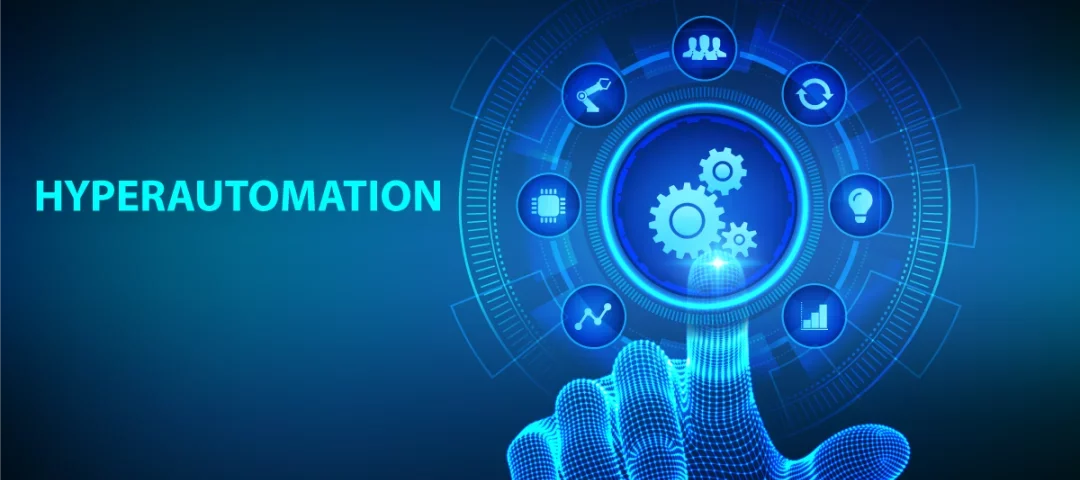Imagine a world where tedious tasks are handled seamlessly by machines, freeing your workforce to focus on innovation and strategic thinking. This is the promise of hyper automation, a revolutionary approach that leverages a combination of powerful technologies to unlock unprecedented levels of efficiency and productivity.
What is Hyper automation?
While automation has been around for decades, hyper automation takes it to a whole new level. It’s not just about automating individual tasks; it’s about creating an intelligent automation ecosystem that orchestrates a symphony of technologies to automate entire processes and workflows.

The key ingredients in this hyper automation recipe include:
- Robotic Process Automation (RPA): These software robots mimic human actions, automating repetitive tasks within digital interfaces. Think of them as tireless digital assistants.
- Artificial Intelligence (AI): AI capabilities like machine learning and natural language processing (NLP) empower hyper automation to handle complex tasks that require judgment and decision-making.
- Process Mining: This technology analyzes existing business processes to identify areas ripe for automation and improvement.
- Analytics and Business Intelligence: Hyper automation leverages data analytics and business intelligence tools to gain insights and optimize automated workflows.
- Integration Platforms as a Service (iPaaS): iPaaS acts as the glue, seamlessly connecting different automation tools, applications, and data sources.
Why Hyper automation Matters?
The benefits of hyper automation are far-reaching:
- Soaring Efficiency and Productivity: By automating repetitive tasks, hyper automation frees up your human talent to focus on higher-value activities that drive innovation and growth.
- Enhanced Accuracy and Consistency: Automated workflows are less prone to human error, ensuring consistent and reliable outcomes.
- Customer Satisfaction Boost: Hyper automation can improve customer service by automating tasks like order processing and complaint resolution, leading to faster and more efficient interactions.
- Cost Optimization: Automating tasks minimizes labor costs associated with manual work. Hyper automation can also help optimize resource allocation and reduce operating expenses.
- Data-Driven Decisions: Hyper automation leverages analytics and AI to provide valuable insights into business operations, enabling data-driven decisions for improved performance.
- Increased Agility: Automated processes are easier to scale up or down as business needs evolve. Hyper automation fosters a more agile business environment, allowing for faster adaptation to changing market conditions.

The Hyper automation Revolution Across Industries
Hyper automation isn’t just a buzzword; it’s a game-changer across industries:
- Manufacturing: Imagine automating production line operations, quality control, and supply chain management with hyper automation, leading to significant efficiency gains and cost reductions.
- Healthcare: Hyper automation can streamline administrative tasks in hospitals, automate appointment scheduling, and even assist with medical diagnosis and treatment planning, improving patient care and operational efficiency.
- Finance: Automating loan processing, fraud detection, and customer service can enhance accuracy and streamline financial operations, freeing up resources for strategic initiatives.
- Retail: Hyper automation can personalize customer experiences, optimize inventory management, and automate supply chain processes, leading to improved customer satisfaction and operational efficiency.
Taking the First Step: Implementing Hyper automation
While hyper automation offers a wealth of benefits, there are challenges to consider:
- Initial Investment: Implementing hyper automation can involve upfront costs for technology, training, and change management.
- Change Management: Shifting towards an automated workforce requires careful planning and communication to address employee concerns about job displacement.
- Data Security and Governance: Integrating various technologies raises concerns about data security and privacy. Strong data governance practices are essential.
- Process Complexity: Hyper automation is most effective for well-defined and standardized processes. Complex processes with high variability may require significant upfront work.
- Technical Expertise: Integrating and managing a hyper automation ecosystem requires skilled professionals with expertise in automation tools and technologies.
These challenges can be overcome through a well-planned approach. Carefully evaluate your automation needs, identify suitable processes, and invest in employee training to ensure a smooth transition.
Hyper automation: The Road Ahead
Hyper automation is here to stay. As the technology matures and becomes more accessible, its impact will extend to even more industries, transforming how we work, interact, and make decisions. Are you ready to embrace the hyper automation revolution and unlock a future of unparalleled efficiency and productivity?
For more information about automation visit www.werqlabs.com.
